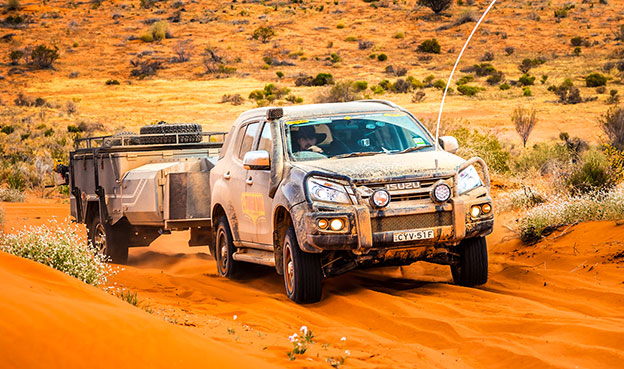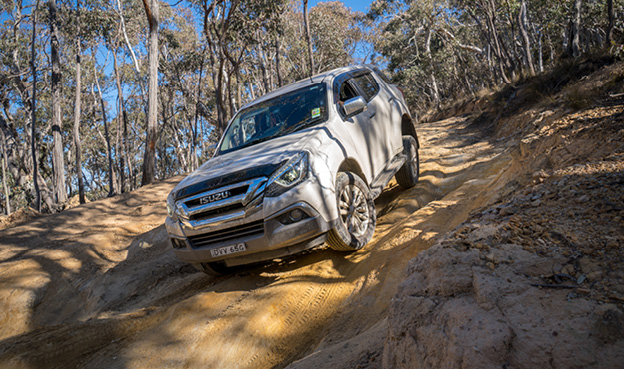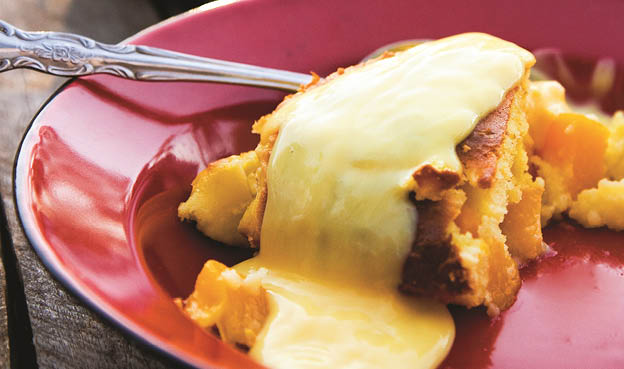

I-Venture’s Coral Coast trip finds true freedom where the remote Australian desert meets the Indian Ocean.
Inspirational types say that the truest freedom is the freedom from fear—and nothing kills fear quicker than knowledge. Out here on the western edge of the continent, across pale dunes, jagged desert coastlines and blood-red bluffs, a plucky band of Isuzu owners has been learning to conquer their anxiety—to master the off-road—in one of Australia’s most pristine landscapes. Stretching from Cervantes in the south to Exmouth in the north, WA’s Coral Coast is a wild, 1100km run, an endlessly variegated coastal verge taking in ancient landscapes that seem to shift and change as quickly as we change gears in our D-MAXs and MU-Xs. The mission at the heart of these trips is simple: to instil a sense of adventure, and ultimately, self-reliance, in the participants. This part of the country is the perfect place to accomplish both, with the added bonus of being hemmed in by astounding natural beauty.

BUSH HISTORY
We began in Geraldton, with many I-Venturers coming from as far afield as the east coast, everyone’s spirits high. Smack in the middle of Geraldton on a hill overlooking Champion Bay is a monument to the HMAS Sydney II. This coast is littered with hapless shipwrecks with Dutch, French and English names, but the sheer scale of the tragedy of the Sydney is unmatched. This tribute in stone and steel stands as a reminder of one awful day: 19 November, 1941.
Not far off the coast here, the warship had gone down after a surprise attack and battle with a German raider, taking all 645 crew with it. It remains the nation’s greatest naval tragedy and, in a way, a stark reminder of how remote and unforgiving this coast can be.
It’s also where we really began our journey into the beyond. From Geraldton we headed north toward Port Gregory, running up the highway before skirting almost straight west. Just outside of town are the Lynton Station ruins, reminders of the convict history of this part of the world, a gnarly set of limestone hulks within which new convicts would be picked for work in the mines or nearby stations. Nothing about the place seems inviting or even what you’d call habitable, and it wasn’t much better back then.

COLOURS OF THE OUTBACK
One thing that everyone on the trip loved, not far up the road, was Hutt Lagoon, one of Australia’s most vibrantly coloured pink lakes. While we may be importing pink salt in expensive artisanal packets from as far away as the Himalayas, Australia has a healthy homegrown supply of pink salt lakes that ring the south and west of the country. The ‘pink’ is the product of secretions by bacteria and algae that thrive in the salt marshes these lakes fill, and while it may not make your food taste any better, these lakes do look fantastic in photos.
From pink to blue, we launched our caravan of Isuzus onto the beach at Port Gregory, cutting through white dunes and lime green dune grass northwest, sometimes undulating through bare dune fields, sometimes skirting the turquoise of the Indian Ocean. About half of the guys along for the trip had been on an I-Venture Club trip before, but some of the newcomers were pretty green. And that’s where David Wilson, who has been running I-Venture trips for a few years now, comes in.
His esprit de corps, combined with an amazing knowledge of 4WDing and safety, make David not just a good bloke to have around, but it means you’re absolutely going to learn something new about your 4WD. Inevitably, someone always gets stuck on their first day sand driving. It’s just the nature of the beast. But David sees getting bogged as an opportunity and takes the time to walk everyone through any recovery we end up doing, showing them the safe, effective way to handle each situation. Even after spending all day running up and down dunes like turbo-diesel Lawrences of Arabia, nothing can quite prepare you for the pindan cliffs and slamming swell of Kalbarri, a town perched at the edge of nowhere.

THE WILD GETS WILDER
Besides being home to a dwindling population of old abalone divers and long-line fishermen, their dilapidated shacks still littering the beaches and cliffs outside of town, Kalbarri is the gateway to some of the wildest country on the west coast. It is the home to the famous Nature’s Window rock formation in the middle of Kalbarri National Park. And like that window, the next two days would give everyone a picture-postcard view of this westside wilderness; a kaleidoscope of sand, stone and water. The hike down to Nature’s Window isn’t too strenuous, and if you’re here to get a great shot, the best time to come is sunset. The rusty, old, blood-coloured stone lights up when the setting sun red-shifts, and the dusk paints the entire landscape in oversaturated hues.
This part of the world once looked more like Shark Bay than the dry, desolate cliff country it is now. You can see many fine ripples in the layers of flat stone stacked immeasurably in the hills here, and fine tubes of petrified worm casings running through the stone—all evidence that this range of mountains was once at the bottom of a shallow sea.
At Nature’s Window, wind and water have worn this ancient stone into strange shapes. None is more famous than this vertical plane of layers with a big viewing hole seemingly punched right through—revealing a broad vista out over the Murchison River and beyond.

STATION TO STATION
North of Kalbarri National Park lies an expanse of sand and scrub that reaches 60km up the coast and takes in 350,000 acres. This is Murchison House Station. Established a century-and-a-half ago to run sheep and wheat, it still operates, now running cattle and goat. For us, Murchison offered a spider web of 4WD tracks that trace its rivers, creeks and coastline, providing every possible terrain to test out the D-MAXs and MU-Xs in low range.
Once we got to the station house, everyone let some air out of their tyres, and it wasn’t long before David was on the radio directing everyone to drop into low range, and then walking everyone through how to do it. The tracks swiftly graded up, from twin goat tracks through lush river valleys to sheer stone escarpments and jump-ups. Here, life comes at you fast.
This is where having a good guide really comes in handy and also where people seem to learn the most about what their 4WDs are capable of. David would guide everyone through the trickier bits and the joy on their faces when they realised that the car they’d never even taken off the tarmac before had just climbed a rock ledge that looked impossible, was priceless.
We stopped for lunch under a bank of river trees, surrounded by wattle in full flower, and then the adventure began again, tracing lines through the underbrush, up and over steep rocky country and back into vibrant valleys full of wildflowers. Back in town we all shared dinner and a few beers. Everyone buzzed about their favourite moments, about the bits that scared them the most, and how they were definitely coming back for more soon.
In the morning, we made our way back out to the station to tackle some even steeper terrain, with the guys getting to test out some of the onboard technology such as downhill assist, and David taking everyone through gear selection and the business of picking the right line over some pretty hairy tracks. Finally we edged our way down to the Indian Ocean, rolling and scrabbling and laughing down steep limestone tracks, until we found another perfect dune field overlooking the ragged ocean.

As finales go, they don’t come much better. And this time, watching the guys humming along the windswept landscape, there was something tangibly different about the drivers. They had left their fear back on the asphalt somewhere. They had been baptized in sand and mud, educated and brought into the light of true freedom. But then, that’s what we’re here for, right?
To keep in touch with Isuzu Owner events, visit www.isuzuute.com.au/experience/i-venture-club





